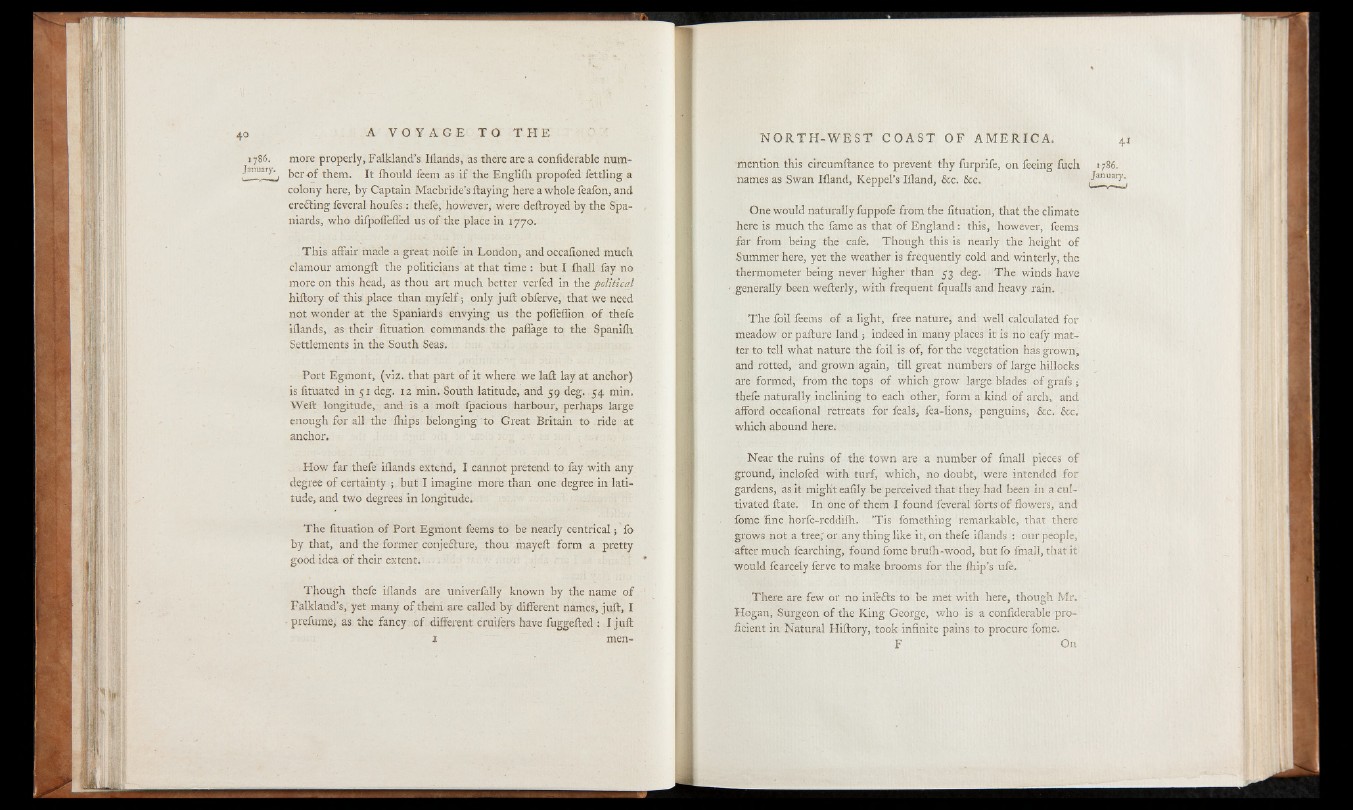
Si
I786.
January.
more properly,Falkland’s Iflands, as there area confiderable number
o f them. It fhould feem as if the Englifh propofed fettling a
colony here, by Captain Macbride’s flaying here a whole feafon, and
erecting lèverai houfes : thefe, however, were deftroyed by the Spaniards,
who difpoffeffed us of the place in 1770.
This affair made a great noife in London, and occafioned much
clamour aniongfl the politicians'at that time : but I fhall fay no
more on this head, as thou art much better veiled in the political
hiflory of this place than myfelf; only juft obferve, that we need
not wonder at the Spaniards envying us the poffeflion of thefe
iflands, as their fituation commands the paffage to the Spanifh.
Settlements in the South Seas.
Port Egmont, (viz. that part of it where we laft lay at anchor)
is fituated in 51 deg. 12 min. South latitude, and 59 deg. 54 min.
Weft longitude, and is a moft fpacious harbour, perhaps large
enough for all the fhips belonging to Great Britain to ride at
anchor.
How far thefe iflands extend, I cannot pretend to fay with any
degree of certainty ; but I imagine more than one degree in latitude,
and two degrees in longitude.
The fituation of Port Egmont feems to be nearly centrical j fo
by that, and the former conjecture, thou mayeft form a pretty
good idea of their extent.
Though thefe iflands are univerfally known by the name of
Falkland’s, yet many of them are called by different names, juft, I
prefume, as the fancy of different cruifers have fuggefted : I juft
H i i
mention this circumftance to prevent thy furprife, on feeing fuch 1786.
names as Swan Ifland, Keppel’s Ifland, &c. &c. January..
One would naturally fuppofe from the fituation, that the climate
here is much the fame as that of England: this, however, feems
far from being the cafe. Though this is nearly the height of
Summer here, yet.the weather is frequently cold and winterly, the
thermometer being never higher than 53 deg. The winds have
generally been wefterly, with frequent fqualls and heavy rain.
The foil feems of a light, free nature, and well calculated for
meadow or pafture land ; indeed in many places it is no eafy matter
to tell what nature the foil is of, for the vegetation has grown,
and rotted, and grown again, till great numbers of large hillocks
are formed, from the tops of which grow large blades .of grafs ;
thefe naturally inclining to each other, form a kind of arch, and
afford occafional retreats for feals, fea-lions, penguins, &c. &c.
which abound here.
Near the ruins of the town are a number of fmall pieces of
ground, inclofed with turf, which, no doubt, were intended for
gardens, as it might eafily be perceived that they had been in a cultivated
ftate. In one of them I found feveral forts of flowers, and
fome fine horfe-reddifh. ’Tis fomething remarkable, that there
grows not a tree; or any thing like it, on thefe iflands : our people,
after much fearching, found fome brufh-wood, but fo fmall, that it
would fcarcely ferve to make brooms for the fhip’s ufe.
There are few or no infects to be met with here, though Mr.
Hogan, Surgeon of the King George, who is a confiderable proficient
in Natural Hiftory, took infinite pains to procure fome.
F On